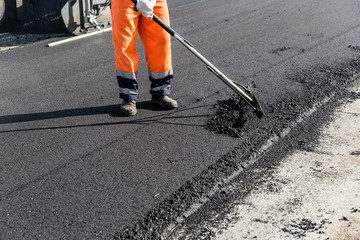If you have a road to pave, you will need to know about the basics of asphalt paving. The material comprises crushed stone in varying particle sizes coated with bitumen. Because of its high density, asphalt can be easily separated if not handled with care. To keep the mix moving, the truck and the paver need to be designed so that it does not segregate.

The process of Asphalt Paving Summerville SC begins with preparing the aggregates. These materials are transferred to the mixer, and the binding element is kept in separate heated tanks. The liquid asphalt is added to the aggregates at a prescribed flow rate. The result is a uniform paving material. The mixture is then rolled on the job site to compact it. The resulting paving material is ready for use as soon as cooled. However, the asphalt must remain high throughout the paving process, as it can’t be compacted if it cools too much.
Screeds are also part of the asphalt paving process. The purpose of these machines is to distribute and compact the asphalt. They have many features that enhance the final appearance of an asphalt pavement. They are used on streets where they are not often accessed by the public and do not require heavy traffic. But in certain circumstances, they are not suitable. For example, if you want to pave a parking lot, you should use a tracker paver. These vehicles have excellent traction.
The binder course should be designed to withstand the highest shear stresses, which occur at about 50-70 mm below the surface. Its function is to provide rut-free surfaces and reduce buckling. Stiff binders and stone-on-stone contact provide stability. The base course is the most important structural layer in asphalt paving, and it should have adequate strength and stiffness to distribute the traffic load. The maximum amount of asphalt should be around 0.95 X 156.0.
Cracks can be caused by various factors, including heavy vehicle weight and lack of support. When cracks form, they may be caused by poor adhesion between the asphalt and aggregate. This can result in fatigue cracking, crocodile cracks, and other problems. Further, cold temperatures can cause cracks as the asphalt contracts. In such cases, cracks may form. But if a patch is already present, it is best to call a paving contractor.
Good design is crucial to the life of your asphalt pavement. It starts with evaluating the sub-soil and traffic in the area to determine the right level of reinforcement. Proper drainage is necessary to keep water from weakening the sub-base and roadbed. When needed, geogrids can help reinforce the sub-base. Finally, seal coating prevents water from penetrating the surface and affecting its resiliency.
The most common type of asphalt is a hot mix. This is a mixture of asphalt, sand, and stone. This type of asphalt can be used for both highways and low-traffic areas. Different asphalt mixes contain different percentages of coarse gravel and sand. Hot mix asphalt can be classified into dense-graded, stone matrix, and open-graded mixes. Compared to open grade asphalt, the dense-graded combination is more fuel-efficient and requires fewer binding materials.
Testing is essential for assessing the structural performance of asphalt pavements. To ensure a pavement’s structural integrity, the thickness of the asphalt layer must be adequate. The thickness design of an asphalt pavement requires the use of the MS-23 Manual, and the stiffness of the hot mix asphalt surface is affected by temperature and load duration. Adding steel plates below a point load helps resolve this problem. Alternatively, rigid material plates can be used to distribute the load.
Another major advantage of asphalt is that it is highly durable. Although concrete is susceptible to damage from snowplows, asphalt is highly durable and resilient. With proper maintenance, asphalt can last anywhere from twenty to twenty-five years. It’s also flexible enough to take the strain of heavy vehicles and equipment. You can even use it for parking lots and driveways. And because asphalt has no curing time, it can be applied very quickly to a large surface area.
There are two basic types of asphalt. Cold mix asphalt is a coarse, non-porous mix largely used for pothole repairs. Because it repels water, it is mainly used for repair projects. Cold mix asphalt has a shorter life span and is not recommended for heavy-trafficked roads. These two types of asphalt can be mixed with a variety of textures and colors. You can also choose a different mix of asphalt for the surface course if you want a different look.